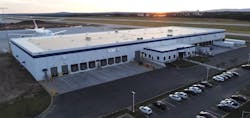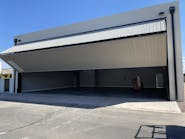Laredo International Airport (LRD) is working on a full rehabilitation of the cargo and general aviation side of the airport. This includes a new ramp area to expand and enhance cargo operations.
Jeffery Miller, director of LRD said the old asphalt ramp was creating FOD issues. Airport leaders brought in FAA officials to share the concerns and eventually secure funding for the project, which was awarded $55 million during the past five years.
When completed, the apron will be more than 3.3 million square feet. Phase 11 and 12 alone covered more than nine football fields in space. LRD recently broke ground on Phase 13 and is now entering Phase 14.
“We’ll be capable of holding 37 Boeing 767 aircraft in conjunction with one another,” Miller said. “It’s a huge expansion of the area.”
The old ramp fell into disrepair after years of not being maintained. The asphalt surface was in poor condition, which created issues for Laredo, which is one of the largest inland ports in the U.S. The airport is the 41st largest for cargo and continues growing.
The ramp houses a joint U.S./Mexico customs operation, which operates 24 hours per day. The facility allows joint inspection between the two countries and reduces delivery time.
“We’re really focused on cargo and giving our operators a chance to unload, load and work with the fixed-base operators like Signature for support,” Miller said.
Crews placed 17 inches of concrete on top of 6 inches of asphalt. The current phase will add additional lighting to the ramp and demolishing two hangars to convert into ramp space.
“It’s a huge investment, but more than anything, it helps us with safety standards,” said Elsy Borgstedte, assistant airport director for LRD. “For the type of aircraft fleet we’re moving around in our airport, it’s really what will make us available for the industry.”
RS&H has been a consultant for Laredo since 2017. It has designed Phases 11, 12, 13 and 14 of the project.
John Hippchen, senior aviation engineer for RS&H, said they’ve had to tweak the design over the years to meet available federal funding. They had to continuously adjust while keeping the project on track to continue construction schedule.
“If that was a single highway lane, it’s 52.5 miles of highway lane miles,” Hippchen said. “It’s a substantial amount of concrete.”
The project removed old taxiway and green space, which was added to the ramp space to create more parking for aircraft.
“Unlike before, depending on the type of aircraft and the weight of that aircraft, we couldn’t put them in certain areas because of issues we were having with FOD,” Borgstedte said. “Now with doing this reconstruction we can totally utilize the extent of the ramp without having any concerns for the ground handling gear they have to use to unload the aircraft.”
LRD coordinated with tenants during the ramp construction to help work around operations as the project moved forward. Once completed it will allow better parking opportunities and more fuel-efficient aircraft operations as they will be able to move straight onto the taxiway.
“At no time has the airport wanted to disrupt the operations,” Borgstedte said. “We want to work very closely with our stakeholders to make sure that the operations have minimal impact if any and work around them and the different operations they have in order to allow them while construction is still ongoing.”
Laredo plans to build new taxiways once the ramp is completed. The improvements mean the airport can service cargo aircraft of most any size safely. “It’s really a fine example of a relationship between the airport and the city and the FAA in truly recognizing the importance of it,” said Amanda O’Krongley, vice president of aviation for RS&H. “It’s not just a piece of pavement. Normally, cargo ramp space isn’t typically a high priority, so the recognition to get the federal funding for a piece of pavement that’s not a runway, that’s not a taxiway, but is an economic generator for the city.”
LRD is working with the Mexican government to expand opportunities. The Mexican preclearance program is limited to aerospace, automotive, electronics and electrical components. However, e-commerce is an emerging industry in Mexico, but Prime Flights don’t fly to Mexico.
“We have the staff today, we have the ramp we have the runways, we really just need the Mexican government to change some of the laws to allow a company like Amazon to use the program,” Miller said. “If we’re successful in conversations like that, there will be exponential growth.”
GSP triples capacity
Greenville-Spartanburg International Airport (GSP) opened a $33 million air cargo facility in September to increase its ability to handle domestic and international freight.
GSP’s 2018 economic impact study found that the airport has a $2.9 billion impact on the Upstate economy. Cargo operations at GSP contribute $478 million to the region’s economy. It moved up to No. 59 on the FAA’s list that ranks air cargo volume for airports in the U.S. More than 100 million pounds of cargo moved through the airport in 2018.
Kevin Howell, senior vice president and chief operating officer for the Greenville-Spartanburg International Airport District, said air cargo has grown in recent years. Cargo flights to Germany now take place regularly from the airport.
“It really started out to support the automotive industry in our area, which is pretty strong, but the cargo on those flights has diversified,” he said. “We see more health care, we see a lot of different industries getting on board. There’s a lot of synergy between our region and Europe.”
The 110,000 square-foot cargo facility and its 17-acre apron allow the airport to accommodate up to three Boeing 747-800 freighter aircraft simultaneously. This triples GSP’s handling capacity.
The airport performs its own ground handling through its fixed-base operator, Cerulean Aviation. The FBO occupies half of the new facility. Senator International leases the other half to support its service to Frankfurt-Hahn Airport (HHN).
GSP prides itself on being an “easy in, easy out” airport on the passenger side, Howell said, so they wanted to provide the same kind of service on the cargo operations.
“GSP is open for business and ready to provide good service at a good price,” Howell said. “So we’re looking to assist others with cargo needs in the southeast.”
Prior to wide-body service to Germany, a lot of area manufacturers would ship through legacy gateway facilities throughout the southeast and truck to the South Carolina market, Howell said, but airport leaders discovered they would rather use GSP.
“It was closer to their facilities, so the final mile was shorter,” he said. “The product could be loaded and unloaded faster at GSP than at more crowded gateways and they got a better price.”
GSP’s old cargo facility was much smaller and unable to handle multiple days per week of operation. It was located on a congested apron area on the south end of the terminal apron. The new facility is located on the north end, so it segregates cargo and passenger operations.
The new facility also has a higher clearance height, allowing airport staff to break down freight more easily. It also provides more storage.
GSP used a design-build delivery method for the cargo facility, working with Haskell Engineering. Design took about four months and construction lasted about a year. Leaders opted with design-build to get certainty on price and schedule.
“It was a good project for us, GSP and the community,” Howell said. “The apron is large enough to hold three wide-body 747-800s at one time. Within the first few weeks, we had all three positions full for several days.
“Previously where GSP had to turn away business, we’re not having to do that now.”
Gregory Kershaw PE, of WK Dickson, which was the consultant on the ramp, said there is space to add another three parking spaces on the south side of the taxiway for the ramp.
Planners were constrained by space on both the north and south of the new facility. They had to install a dry pond, which was designed for the ultimate buildout.
“If the airport ever wants to come back and expand the next three spaces to the south, the pond is already at a capacity to handle the additional storm runoff from that added impervious area,” he said. “It’s a rather large pond, but we wanted to make sure it wasn’t impacted or in the way.”
A fully loaded 747-800 has a takeoff weight of almost 1 million pounds. The pavement area consists of 19 inches of concrete on top of a 6-inch cement-treated base. It took about four months to finish.
Howell said GSP is working with its partners to continue diversifying cargo on flights as they look to increase the number of flights coming in. It actually saw an increase in cargo in March due to the lack of belly capacity.
“There’s a lot of industry and manufacturers looking to move product over to the freighters now that the belly capacity has dried up,” he said. “It will be interesting to see how we come out of this and if it will be a long-term impact to the market.”
Howell said airports need to know their market before building the right cargo facility. Understand your strengths and weaknesses so you can leverage them.
“You got to make sure you’re not overbuilding or underbuilding your facility,” he said.






